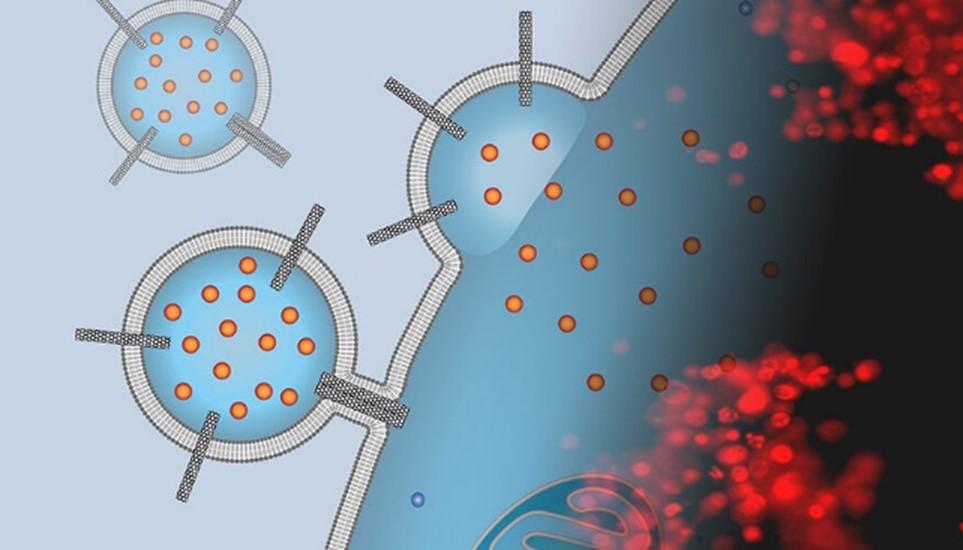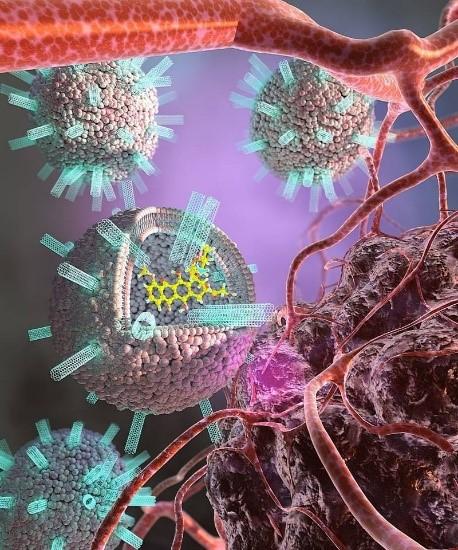There is a high demand for novel technologies for efficient drug delivery, particularly in chemotherapy where delivering drugs into unhealthy cells is still quite difficult. Liposomes, which are spherical vesicles characterized by a bilayer of lipids with an internal aqueous cavity, constitute one class of vehicles for drug delivery. The US FDA has approved several liposomal formulations for the delivery of drugs for the treatment of various disorders, but challenges still remain particularly in the delivery of chemotherapeutic agents that are associated with toxicity.
To address shortcomings of current liposome drug delivery systems, the patented innovation uses drug-loaded liposomes containing carbon nanotube porins (CNTPs) inserted into the liposomal membranes for the delivery of the encapsulated drugs. Short CNTPs (10 nm in length) with narrow diameter (0.8 nm) has been demonstrated to facilitate efficient fusion of lipid bilayers resulting in the complete mixing of the membrane material and vesicle interior content. Drugs encapsulated in the liposome decorated with CNTPs are released into the cytoplasm of the cell upon fusion of the liposomal membrane with the cell membrane.
For proof-of-concept, the delivery of doxorubicin (DOX), a powerful anti-cancer drug that has significant cardiac toxicity in free form, was tested. Scientists used CNTPs to directly introduce DOX from spherical sacs of liposomes through the cell plasma membrane into its interior. Controls such as buffer, CNTP in free form, liposomes with CNTPs on the surface but no DOX, and DOX encapsulated in liposomes without CNTPs on the surface did not show significant effect on viability of cells. On the other hand, DOX encapsulated in liposomes with CNTPs on the surface allowed fusion of the liposome and cell membranes. This permitted direct delivery of the drug and killed cells even to a greater extent than DOX in free form (adjusted for equivalent concentration of the drug).
Ho, N.T., et al., Membrane fusion and drug delivery with carbon nanotube porins, PNAS, 118 (19), e2016974118 (2021) (https://doi.org/10.1073/pnas.2016974118)
Direct drug delivery with carbon nanotube porins | Lawrence Livermore National Laboratory (https://www.llnl.gov/news/direct-drug-delivery-carbon-nanotube-porins)
This innovative pathway to deliver a drug directly into a cell interior addresses a long-standing challenge for medicine. Carbon nanotube porins allows for efficient drug delivery of liposomal formulation of drugs. Conventional liposomes rely on endocytic uptake of liposomes and fusion of the liposomes with endosomal membrane, which is not very efficient. The novel approach uses CNTPs embedded in liposomal membrane to actively promote fusion of the liposomal membrane with the cell membrane and thereby achieve higher efficiency of drug delivery.
Drug delivery that incorporates carbon nanotube porins as therapeutic carriers could be used for treatment of difficult to cure diseases. The technology can also be used for vaccines as well as gene delivery for immunization and gene therapy, respectively.
Current stage of technology development: TRL-2 (3/2023)
U.S. Patent Application Publication No. 2021/0177756 Nanotube-Vesicle Compositions and Uses Thereof published 06/17/2021



